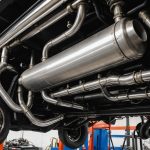Understanding Fuel Efficiency on UK Motorways
Driving on UK motorways demands attention to fuel efficiency due to its significant impact on both economic expenses and the environment. Saving fuel not only reduces travel costs but also contributes significantly to reducing carbon emissions, an important consideration for environmentally conscious drivers.
Several factors affect fuel consumption when navigating these high-speed roads. Maintaining a steady speed, as opposed to constantly accelerating and braking, can enhance fuel efficiency. This is because fluctuating speeds make engines work harder, consuming more fuel. The weight of the vehicle, aerodynamic drag, and even tyre pressure can all influence how efficiently a car uses fuel.
This might interest you : Top All-Season Tyres to Tackle Varying UK Weather Conditions Effectively
Strategies to improve motorway fuel efficiency include using cruise control to maintain consistent speeds. This is particularly beneficial on long, uninterrupted stretches of motorway. Minimising air conditioning use, ensuring tyres are properly inflated, and avoiding unnecessary weight can also enhance efficiency. Drivers are encouraged to adopt these driving strategies to optimise fuel consumption.
Being mindful of these strategies and factors can lead to impactful changes, benefiting both the driver’s wallet and the planet’s health. Practising efficient driving techniques doesn’t require dramatic changes to your routine but can lead to substantial long-term benefits.
Topic to read : Exploring the Pros and Cons of Car Subscription Services in the UK: Benefits, Drawbacks, and What You Need to Know!
Maintaining Optimal Speed
Understanding the relationship between optimal speed and fuel consumption is crucial for efficient driving. Vehicles operate most efficiently within specific speed ranges, where fuel consumption is minimized. Maintaining a consistent speed helps manage fuel efficiency, especially on long journeys.
On UK motorways, the recommended speed range for achieving optimal fuel efficiency typically lies between 55 and 60 miles per hour. Driving within this range can significantly reduce fuel consumption, resulting in substantial savings. For instance, reducing your motorway speed from 70 mph to 60 mph can improve fuel efficiency by as much as 9%, which is a tangible benefit for any driver looking to save on fuel costs.
Real-world Examples
Consider two scenarios: A driver maintains a speed of 70 mph, while another chooses to drive at 60 mph on a 100-mile motorway trip. The second driver will likely save several pounds on fuel costs. With consistent speed management, these savings accumulate over time, resulting in reduced energy use and a smaller carbon footprint.
Utilizing effective speed management not only fosters fuel savings but also enhances driving safety and prolongs the vehicle’s lifespan, making it a practical approach for all road users.
Proper Gear Usage
Understanding proper gear usage is essential not only for achieving maximum fuel savings but also for enhancing engine efficiency. By mastering these techniques, you can minimise wear on your vehicle and improve overall driving economy.
Manual vs Automatic Gear Shifting
Both manual and automatic transmissions offer unique advantages and different levels of control over gear shifting. Manual transmissions allow drivers to select gears precisely, which can lead to better fuel savings when driving styles are adapted to road conditions. This requires understanding when to upshift or downshift optimally to maintain engine efficiency. Conversely, automatics handle shifting for you but may not always prioritize fuel economy unless equipped with specific eco-modes.
Engine RPM and Fuel Efficiency
Maintaining appropriate engine RPM (revolutions per minute) is crucial for optimising fuel usage. Operating in the ‘sweet spot’—usually between 1,500 to 2,500 RPM—ensures the engine isn’t labouring or revving excessively, both of which detract from fuel efficiency. Efficient driving compensates by aligning engine power with road requirements without unnecessary fuel consumption.
Downshifting Techniques
Downshifting might improve fuel economy by allowing the engine to brake the vehicle, potentially reducing reliance on the brake pedal. Dropping to a lower gear increases engine braking and can enhance fuel savings during deceleration phases, aligning with more sustainable driving practices.
Tire Maintenance for Fuel Efficiency
Understanding tire maintenance is crucial for ensuring optimal fuel economy. One key factor to monitor is tire pressure. Underinflated tires can increase rolling resistance, leading to higher fuel consumption. Keeping tires at the recommended pressure can lead to significant fuel savings. Aim to check tire pressure monthly, especially before long trips, using a reliable gauge.
Maintaining tires also involves more than just monitoring pressure. Regular tire inspections can help identify tread wear or damage that could affect performance. This involves visually checking for any cuts, punctures, or uneven tread patterns that might compromise safety and efficiency. Tires should be rotated every 5,000 to 8,000 miles to ensure even wear, which promotes better fuel efficiency.
Replacing tires when necessary is another important aspect. Worn-out tires can lead to decreased traction and increased energy expenditure from the vehicle. Look for tires that are specifically designed for fuel efficiency, sometimes labeled as “low rolling resistance” tires, which can further enhance fuel savings.
Regular tire maintenance is key to optimizing both vehicle performance and fuel savings. By proactively caring for your tires, you enhance safety, extend tire life, and maximize your vehicle’s fuel economy.
Effective Use of Cruise Control
Cruise control serves as an integral feature for long-distance driving, offering not only comfort but significant benefits in fuel efficiency. This system allows drivers to maintain a consistent, economical speed, which can be particularly advantageous during extended highway journeys.
Cruise control is most beneficial in situations that require a stable speed over long stretches of road with minimal traffic disruptions. For instance, on highways, where maintaining a steady pace can reduce unnecessary fuel consumption, cruise control enables the vehicle to function at optimal efficiency. This steadiness prevents the frequent acceleration and braking that can negatively impact fuel economy.
Research has demonstrated that using cruise control can lead to substantial gains in fuel savings. Studies highlight that maintaining a constant speed reduces engine load and optimises fuel usage, especially in environments where stop-and-go traffic is minimal. Employing cruise control can thus contribute to a more sustainable and cost-effective driving experience.
In conclusion, for effective use, activate cruise control primarily on highways where its features can deliver the most benefit, ensuring both comfort and efficiency in long-distance driving scenarios.
Monitoring Vehicle Performance
Effectively monitoring vehicle performance is crucial for maintaining optimal fuel management and improving engine diagnostics. Regular vehicle maintenance plays a pivotal role in enhancing fuel efficiency. Ensuring that your vehicle is serviced periodically can prevent various issues, such as increased fuel consumption or reduced engine effectiveness.
Moreover, there are numerous tools and apps available to help track fuel consumption and driving habits. These digital solutions provide insights into your average mileage, identifying areas where your driving patterns may be causing unnecessary fuel expenditure. By tweaking driving habits, such as accelerating smoothly or maintaining a steady speed, you can stretch your fuel further and reduce costs.
Understanding engine diagnostics is another avenue for efficiency improvements. Modern vehicles are often equipped with onboard diagnostics systems that generate data reports. These reports are essential in identifying any potential faults within the engine that could affect performance. By interpreting these diagnostic reports accurately, you can address minor issues before they become major problems, ensuring your engine runs efficiently.
In essence, staying informed about your vehicle’s performance through regular maintenance, fuel tracking, and diagnostic interpretations can lead to significant benefits in terms of fuel efficiency and overall vehicle longevity.
Additional Driving Techniques for Efficiency
Enhancing efficiency involves adopting various driving techniques. These techniques focus on eco-driving and fuel conservation to not only save fuel but also reduce environmental impact.
Anticipative Driving
Anticipative driving requires drivers to remain vigilant and anticipate traffic flow changes. By maintaining a consistent speed, drivers can minimise unnecessary braking and acceleration. This smooth driving style contributes to significant fuel savings by reducing the engine’s workload and optimizing the vehicle’s momentum. The key is predicting the actions of other drivers and traffic signals well in advance.
Reducing Idling
Idling, while often overlooked, can significantly increase fuel consumption. When a vehicle is stationary for more than a minute, consider turning off the engine to conserve fuel. Modern engines are designed to handle frequent startups without excessive wear, making this an effective strategy. Reducing unnecessary idling helps conserve both fuel and reduce emissions, promoting ecological driving habits.
Choosing the Right Lane
Lane choice on multi-lane motorways can greatly influence driving efficiency. Always opt for a lane that allows steady flow and reduces the need for frequent lane switching. This practice enhances momentum maintenance and minimizes fuel usage. Optimum lane selection results in a smoother journey, aligning with the principles of eco-driving.
Environmental Benefits of Fuel Efficiency
Improving fuel efficiency has a significant environmental impact by reducing emissions and promoting sustainability. Vehicles with higher fuel efficiency consume less fuel, thereby emitting fewer pollutants such as carbon dioxide into the atmosphere. Lower emissions help mitigate climate change by reducing the greenhouse gases responsible for global warming.
The broader significance of improving fuel efficiency also lies in its potential to contribute to global environmental sustainability. Every small effort made by individuals to drive fuel-efficiently amplifies when adopted at scale. By choosing vehicles that are fuel-efficient or engaging in fuel-saving driving practices, individuals can make a collective difference.
Community Initiatives for Fuel Efficiency
Communities worldwide are rallying behind emissions reduction and conducting initiatives aimed at promoting fuel-efficient driving practices. These initiatives often include educational campaigns that teach drivers how to maintain vehicles properly, ensure optimal tyre pressure, and use the most efficient driving techniques. Community car-sharing programs also reduce the number of vehicles on the road, simultaneously decreasing emissions and conserving resources.
By understanding and adopting these practices, people can significantly lessen their environmental footprint while contributing to the larger goal of a sustainable planet.










